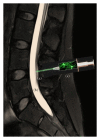Review of the history and current status of cell-transplant approaches for the management of neuropathic pain
- PMID: 22745903
- PMCID: PMC3382629
- DOI: 10.1155/2012/263972
Review of the history and current status of cell-transplant approaches for the management of neuropathic pain
Abstract
Treatment of sensory neuropathies, whether inherited or caused by trauma, the progress of diabetes, or other disease states, are among the most difficult problems in modern clinical practice. Cell therapy to release antinociceptive agents near the injured spinal cord would be the logical next step in the development of treatment modalities. But few clinical trials, especially for chronic pain, have tested the transplant of cells or a cell line to treat human disease. The history of the research and development of useful cell-transplant-based approaches offers an understanding of the advantages and problems associated with these technologies, but as an adjuvant or replacement for current pharmacological treatments, cell therapy is a likely near future clinical tool for improved health care.
Figures

Similar articles
-
Potential for Cell-Transplant Therapy with Human Neuronal Precursors to Treat Neuropathic Pain in Models of PNS and CNS Injury: Comparison of hNT2.17 and hNT2.19 Cell Lines.Pain Res Treat. 2012;2012:356412. doi: 10.1155/2012/356412. Epub 2012 Apr 24. Pain Res Treat. 2012. PMID: 22619713 Free PMC article.
-
Cell therapy for neuropathic pain in spinal cord injuries.Expert Opin Biol Ther. 2004 Dec;4(12):1861-9. doi: 10.1517/14712598.4.12.1861. Expert Opin Biol Ther. 2004. PMID: 15571449 Review.
-
Spinal cord stimulation for neuropathic pain: an evidence-based analysis.Ont Health Technol Assess Ser. 2005;5(4):1-78. Epub 2005 Mar 1. Ont Health Technol Assess Ser. 2005. PMID: 23074473 Free PMC article.
-
Clinical feasibility for cell therapy using human neuronal cell line to treat neuropathic behavioral hypersensitivity following spinal cord injury in rats.J Rehabil Res Dev. 2009;46(1):145-65. J Rehabil Res Dev. 2009. PMID: 19533527
-
Cell and molecular approaches to the attenuation of pain after spinal cord injury.J Neurotrauma. 2006 Mar-Apr;23(3-4):549-59. doi: 10.1089/neu.2006.23.549. J Neurotrauma. 2006. PMID: 16629636 Review.
References
-
- Bennett GJ. Neuropathic pain: new insights, new interventions. Hospital Practice. 1998;33(10):95–114. - PubMed
-
- Torrance N, Smith BH, Bennett MI, Lee AJ. The epidemiology of chronic pain of predominantly neuropathic origin. Results from a general population survey. Journal of Pain. 2006;7(4):281–289. - PubMed
-
- Bouhassira D, Lanteri-Minet M, Attal N, Laurent B, Touboul C. Prevalence of chronic pain with neuropathic characteristics in the general population. Pain. 2008;136(3):380–387. - PubMed
-
- Haanpää M, Attal N, Backonja M, et al. NeuPSIG guidelines on neuropathic pain assessment. Pain. 2011;152(1):14–27. - PubMed
-
- Felix ER, Cruz-Almeida Y, Widerstrom-Noga EG. Chronic pain after spinal cord injury: what characteristics make some pains more disturbing than others? Journal of Rehabilitation Research and Development. 2007;44(5):703–716. - PubMed
LinkOut - more resources
Full Text Sources
